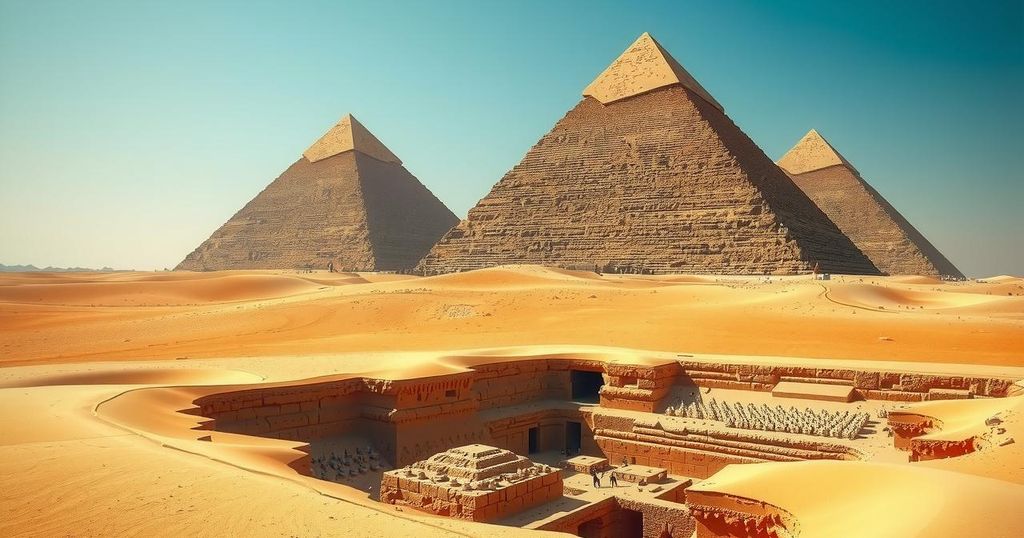Revealing the Secrets of the Giza Pyramids: Discoveries That Could Change History

The recent unearthing of structures and skeletons beneath the Giza Pyramids could reshape historical narratives about ancient Egypt. Discoveries include cylindrical formations and evidence of a diverse work force, challenging the idea of the pyramids as mere tombs, while advanced theories speculate on their potential purposes beyond burial sites.
The Giza Pyramids, renowned symbols of ancient Egypt, may hold secrets that fundamentally alter our historical understanding. Recent archaeological investigations have revealed enigmatic underground formations and unusual skeletal remains that contest traditional narratives of the pyramids’ purposes. The integration of advanced technology with speculative theories raises the possibility that the pyramids served functions beyond mere tombs, thereby transforming our interpretation of ancient civilization.
A remarkable discovery surfaced in the form of enormous vertical cylindrical structures located 648 meters beneath the Giza Plateau, unveiled by a team including Corrado Malanga from the University of Pisa and Filippo Biondi from the University of Strathclyde. Utilizing Synthetic Aperture Radar (SAR), their 2022 study published on arXiv first identified concealed chambers within the Great Pyramid. More findings were released on March 15, highlighting similar structures beneath Khafre’s Pyramid, consisting of five equally sized formations that feature multiple levels and sloped rooftops. Below these, spiraling wells extend 648 meters, connecting to two large cube-shaped structures.
In the latest Giza survey from 2021 to 2023, further anomalies uncovered an L-shaped formation approximately 6.5 feet underground alongside a potential chamber resting 10 to 33 feet into the earth. Motoyuki Sato from Tohoku University remarked that such an L-shape is not attributable to natural geological processes. The 30-foot corridor, recently discovered through the Scan Pyramids project, adds another layer to the growing enigma surrounding the pyramid complex.
In an unexpected turn, skeletal remains uncovered in March 2025, as reported by the Daily Mail, have origins tracing to Nubia, predating the pyramids by several centuries. Osteologist Dr. Sarah Field noted the implications of this finding, which suggests the workforce of pyramid builders was not a homogeneous local population. Conventional Egyptological perspectives deem the pyramids as the burial sites of pharaohs, constructed circa 2500 BCE using ramps, yet these findings challenge and complicate that narrative.
Moreover, the advanced mathematical concepts—such as Pi and the golden ratio—alongside the latest discoveries prompt conjectures. Figures like Nikola Tesla theorized that the pyramids could have harnessed Earth’s energy, while Christopher Dunn proposed their function as a power plant for converting vibrations into electricity. The prospect of cylindrical wells channeling energy or sound, with cubes acting as generators, persists. Journalist Greg Reese noted that the team hopes to excavate further, despite the uncertainty surrounding permits. Thus, the story of the pyramids begins to resemble a science fiction saga poised for revelation rather than a mere historical account.
In summary, recent discoveries beneath the Giza Pyramids, including remarkable geometric structures and diverse skeletal remains, challenge long-held beliefs regarding these ancient monuments. The application of advanced technology in archaeology unveils a potentially complex and multifaceted history of pyramid construction and purpose. By investigating these theories, researchers are on the path of reinterpreting the historical significance of these iconic structures amidst contemporary scientific discourse.
Original Source: www.marca.com






